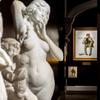When Time Was Born: Renaissance-Period Clocks
- June 13, 2014 08:22


Mention the Renaissance, and most people envision the revival of Classical literature and art after the dark days of the Medieval, or Middle Ages. But did you know that some of the world’s most important conveniences were invented during this period of cultural rebirth? The printing press, the match, and even the flush toilet are just a few of those pivotal creations. One invention, however, not only filled a need in society, but also provided us with some of the most stunning mechanical works of art ever made…the clock.
The clock is perhaps one of the most important inventions of the Renaissance. Before this, time was kept via sundials, which are actually quite accurate within a minute or so. Of course, that is dependent on the sun shining, making it impossible to tell time on overcast days or at night. In the Mid- and Far East, the water clock was quite popular, and worked on a concept of water displacement, with a particular amount of displaced water indicating a specific amount of time. These eventually found their way to Europe, where they were used until the end of the 13th century. Though accurate, these elaborate mechanisms depended on an individual constantly monitoring the mechanism day and night.
The first known example that resembles what we think of as a clock was built in the town of Dunstable, in Bedfordshire, England in 1283. Known as a turret clock, these mechanisms were large, weight driven devices that were placed in tall building towers, or turrets, in the center of town. They lacked faces or hands, and simply struck the hours for all to hear. Soon, the desire to make clocks smaller, more portable and user friendly spurred the creation of the spring-driven clock in the 1400s. This not only allowed timekeeping to be brought in the home, but it also gave artisans the chance to showcase their technical and artistic talents.
This incredible Renaissance Turret (Table) Clock displays impeccable artistry inside and out. It’s firegilt brass case is enveloped in exquisite engravings paying homage to the Liberal Arts, while the gut/fuseé movement with verge escapement allows the timepiece to strike on the hour. As you can tell, the form of the clock resembles the building turrets of its giant predecessor, and indicates only the hour using a single iron hand. Mechanical innovations allowed these clocks to become more complex, and accurate. This later 17th Century Turret Clock still has the single hand, but has the addition of an alarm and striking on the hour and quarter hour.

Considered both a scientific marvel and an item of luxury during the period, Renaissance clocks are the embodiment of mankind’s rebirth and acknowledgement of his place in the world. Found mainly in some of the most prestigious museums in the world, including the Frick Collection and the Metropolitan Museum of Art in New York, Renaissance clocks of this condition and quality are extremely rare and truly timeless treasures.
To learn more and view our collection of Renaissance clocks, click here.
About M.S. Rau Antiques: M.S. Rau Antiques has spent over 100 years earning the trust of discerning collectors world-wide. Located in the heart of New Orleans’ historic French Quarter, our peerless gallery showcases some of the world’s most extensive and stunning works of important fine art by artists such as Monet and van Gogh, rare 18th-and 19th-century antiques and breathtaking jewelry, including rare colored diamonds.
















_(17100x100_c.jpg)




